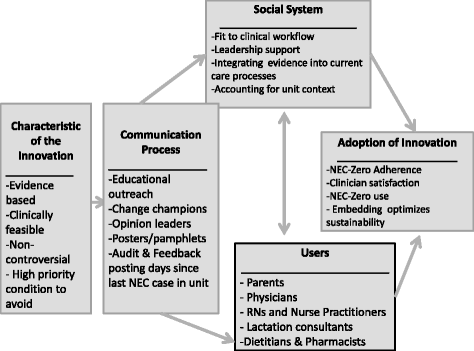NEC-zero recommendations from scoping review of evidence to prevent and foster timely recognition of necrotizing enterocolitis
- PMID: 29270303
- PMCID: PMC5733736
- DOI: 10.1186/s40748-017-0062-0
NEC-zero recommendations from scoping review of evidence to prevent and foster timely recognition of necrotizing enterocolitis
Abstract
Background: Although decades have focused on unraveling its etiology, necrotizing enterocolitis (NEC) remains a chief threat to the health of premature infants. Both modifiable and non-modifiable risk factors contribute to varying rates of disease across neonatal intensive care units (NICUs).
Purpose: The purpose of this paper is to present a scoping review with two new meta-analyses, clinical recommendations, and implementation strategies to prevent and foster timely recognition of NEC.
Methods: Using the Translating Research into Practice (TRIP) framework, we conducted a stakeholder-engaged scoping review to classify strength of evidence and form implementation recommendations using GRADE criteria across subgroup areas: 1) promoting human milk, 2) feeding protocols and transfusion, 3) timely recognition strategies, and 4) medication stewardship. Sub-groups answered 5 key questions, reviewed 11 position statements and 71 research reports. Meta-analyses with random effects were conducted on effects of standardized feeding protocols and donor human milk derived fortifiers on NEC.
Results: Quality of evidence ranged from very low (timely recognition) to moderate (feeding protocols, prioritize human milk, limiting antibiotics and antacids). Prioritizing human milk, feeding protocols and avoiding antacids were strongly recommended. Weak recommendations (i.e. "probably do it") for limiting antibiotics and use of a standard timely recognition approach are presented. Meta-analysis of data from infants weighing <1250 g fed donor human milk based fortifier had reduced odds of NEC compared to those fed cow's milk based fortifier (OR = 0.36, 95% CI 0.13, 1.00; p = 0.05; 4 studies, N = 1164). Use of standardized feeding protocols for infants <1500 g reduced odds of NEC by 67% (OR = 0.33, 95% CI 0.17, 0.65, p = 0.001; 9 studies; N = 4755 infants). Parents recommended that NEC information be shared early in the NICU stay, when feedings were adjusted, or feeding intolerance occurred via print and video materials to supplement verbal instruction.
Discussion: Evidence for NEC prevention is of sufficient quality to implement. Implementation that addresses system-level interventions that engage the whole team, including parents, will yield the best impact to prevent NEC and foster its timely recognition.
Keywords: Clinical practice guideline; Evidence-based practice; Infant; NEC-zero; Necrotizing enterocolitis; Neonatal intensive care; Nursing; Parent engagement; Practice guidelines; Prevention; Scoping review; Translating Research into Practice Framework; Very low birth weight.
Conflict of interest statement
This project was deemed not research. Results present a review with expert assessment of recommendations and implementation strategies. All experts participated without coersion.All authors give consent for publication and assure that the paper is not in review by another journal nor have they been published before.The authors declare that they have no competing interests.Springer Nature remains neutral with regard to jurisdictional claims in published maps and institutional affiliations.
Figures
References
-
- Fanaroff AA, Stoll BJ, Wright LL, et al. Trends in neonatal morbidity and mortality for very low birthweight infants. Am J Obstet Gynecol. 2007;196(2) doi:10.1016/j.ajog.2006.09.014. - PubMed
Publication types
Grants and funding
LinkOut - more resources
Full Text Sources
Other Literature Sources




